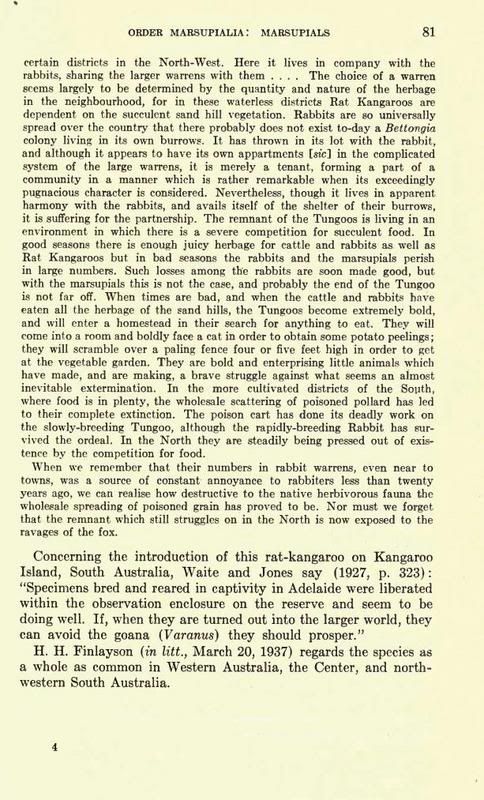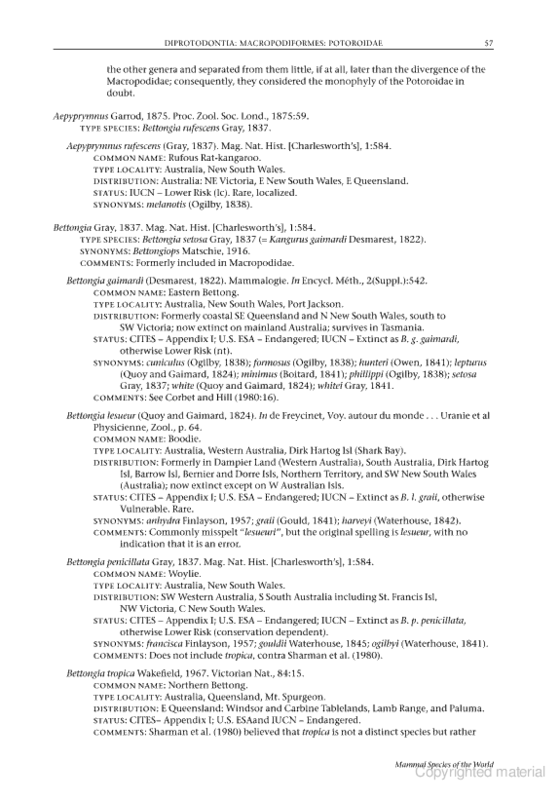Post by another specialist on Sept 9, 2007 18:32:56 GMT
Burrowing bettong
The burrowing bettong was first described by naturalists Quoy and Gaimard in 1824, from a specimen collected on Dirk Hartog Island in Shark Bay by de Freycinet on the Uranie in 1817. The species was named after Charles Alexandre Lesueur, artist on board the Geographe, exploring the Shark Bay region for the French in 1801 (Horner 1987). Several forms have been identified, including B. l. lesueur from Bernier and Dorre Islands, and an undescribed subspecies from Barrow and Boodie Islands (those from Boodie Island were unintentionally eradicated in 1985 during a program to rid
the island of black rats, and reintroduced from Barrow Island in 1993 (Morris 2002)). Dorre Island animals are typically larger than those on Bernier Island, Barrow Island animals are considerably smaller than those on the Shark Bay islands, and the island animals appear to be smaller than their mainland counterparts (Short and Turner 1999). Felicity Donaldson, a PhD student from the University of Western Australia, proposes to examine this taxonomy. The extinct mainland subspecies have been referred to as B. l. graii from south-west Western Australia, and B. l. harveyi from the Eyre Peninsula of South Australia, however the validity of this nomenclature is not generally accepted (Burbidge 1995).
The burrowing bettong is one of the rat-kangaroos and a member of the Family Potoroidae. They are nocturnal and omnivorous, and are social animals, living in communal warren systems (Sander et al. 1997). They are unusual in that they are the only macropod to build and inhabit burrows. They are medium sized, with an average weight of 1300 g and a pugnacious disposition. The last museum record of its occurrence on mainland Australia was in 1942 in south-western WA (Kitchener and Vicker 1981), however there is evidence of its persistence until the 1960s in central Australia (Burbidge et al. 1988). Wild populations survive on Bernier and Dorre Islands in Shark Bay, and on Barrow Island, in Western Australia.
Burrowing bettongs are characterised by a short blunt head, with small rounded and erect ears. They are yellowy-grey in colour, though the ventral surface tends to be lighter, while the legs, feet and tail are more yellow in colour (Jones 1923-25). In some animals the tail has a distinctive white tip.
www.cse.csiro.au/publications/2003/sbmarsupialsrecpln.pdf
The burrowing bettong was first described by naturalists Quoy and Gaimard in 1824, from a specimen collected on Dirk Hartog Island in Shark Bay by de Freycinet on the Uranie in 1817. The species was named after Charles Alexandre Lesueur, artist on board the Geographe, exploring the Shark Bay region for the French in 1801 (Horner 1987). Several forms have been identified, including B. l. lesueur from Bernier and Dorre Islands, and an undescribed subspecies from Barrow and Boodie Islands (those from Boodie Island were unintentionally eradicated in 1985 during a program to rid
the island of black rats, and reintroduced from Barrow Island in 1993 (Morris 2002)). Dorre Island animals are typically larger than those on Bernier Island, Barrow Island animals are considerably smaller than those on the Shark Bay islands, and the island animals appear to be smaller than their mainland counterparts (Short and Turner 1999). Felicity Donaldson, a PhD student from the University of Western Australia, proposes to examine this taxonomy. The extinct mainland subspecies have been referred to as B. l. graii from south-west Western Australia, and B. l. harveyi from the Eyre Peninsula of South Australia, however the validity of this nomenclature is not generally accepted (Burbidge 1995).
The burrowing bettong is one of the rat-kangaroos and a member of the Family Potoroidae. They are nocturnal and omnivorous, and are social animals, living in communal warren systems (Sander et al. 1997). They are unusual in that they are the only macropod to build and inhabit burrows. They are medium sized, with an average weight of 1300 g and a pugnacious disposition. The last museum record of its occurrence on mainland Australia was in 1942 in south-western WA (Kitchener and Vicker 1981), however there is evidence of its persistence until the 1960s in central Australia (Burbidge et al. 1988). Wild populations survive on Bernier and Dorre Islands in Shark Bay, and on Barrow Island, in Western Australia.
Burrowing bettongs are characterised by a short blunt head, with small rounded and erect ears. They are yellowy-grey in colour, though the ventral surface tends to be lighter, while the legs, feet and tail are more yellow in colour (Jones 1923-25). In some animals the tail has a distinctive white tip.
www.cse.csiro.au/publications/2003/sbmarsupialsrecpln.pdf




